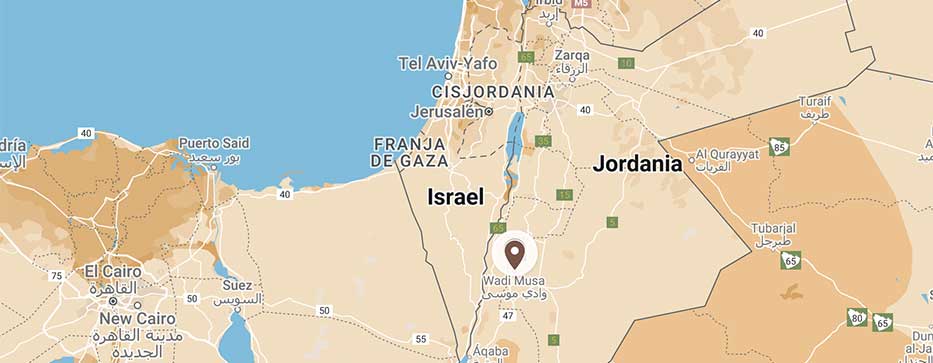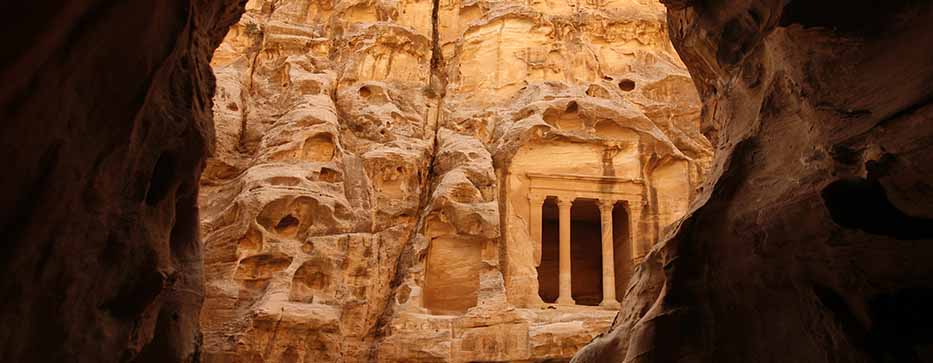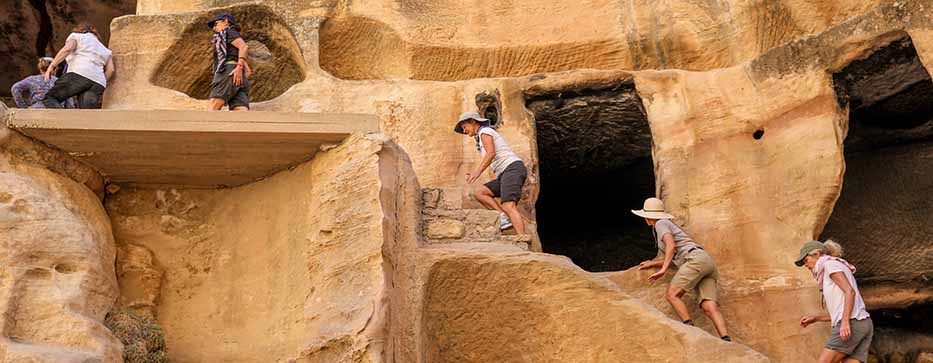Little Petra, also called Siq Al Barid (meaning ‘cold cannon’), can be considered Petra’s ‘younger sister’, or its small-scale equivalent. And as often happens in these cases, its beauty is very similar, but its influx of public is much smaller. Therefore, visiting this unique space can be very rewarding and recommended, especially for those who prefer to avoid large crowds of tourists. So on this page we tell you what to see in Little Petra and we give you other information that will be of interest to you.
Little Petra It is located approximately 10 km north of Petra, specifically on the outskirts of the small town of Al-Baydha. That is, we are talking about the south-central sector of Jordan, within the Ma’an governorate, about 220 km from Amman, 100 km from Wadi Rum and 140 km from Aqaba.
The climate is also similar to that of Petra, which means summers of suffocating heat during the day (cooler nights) and winters with nights that can become icy (milder days but with a greater possibility of rain). That leaves the months of March, April and May as the most suitable for the visit, as well as those of October and November. Outside of those dates, it is possible to visit the Little Petra, of course, but you will have to do it with more careful equipment, especially in terms of clothing and sun protection.

Petra’s story has a lot to do with Little Petra, since both spaces are closely linked. It is true that it was not a city (as it was Raqmu, the name given to it by the Nabataeans themselves), but it was a small settlement that must have functioned as their auxiliary center, perhaps as an agricultural or resting area for the caravans of merchants who were passing through because their route brought them obligatorily to Petra.
These are some brushstrokes that will help you understand the passage of time through Little Petra:

Little Petra lives up to its name: its structures are largely reminiscent of those of Petra, but the enclosure is much smaller. In any case, Petra was his clear inspiration, as many of his monuments and techniques are reproduced here in Siq Al Barid: a cannon articulates the space and numerous structures are excavated in stone, although they do not seem to have such an obvious funerary function. In this case it has two narrow accesses, one to the east and one to the west. The eastern access is the most used to enter, being closer to Al Beidha and the road, while the eastern access is formed by a large staircase carved into the rock.
The main places to see in Little Petra are:

One of the most interesting proposals to do in Little Petra It is hiking: the routes through the environment are numerous, in a very characteristic natural environment and with spectacular panoramic views. It is no coincidence that the Jordan Trail passes through here, a route that runs throughout the country: the section that passes through this area can be done in 5 days, and covers more or less from Petra to Wadi Rum.
In any case, for those looking for something shorter and more affordable, one of the most outstanding routes is the ‘back door trail’, so called because it connects the back of Petra, where Al Deir Monastery is located, with Little Petra. At the highest points of this tour, you can even see on the horizon the terrain of Wadi Araba and, beyond, the Palestinian Territories and Israel.
And lovers of history and archaeology have another very important thing to see in Little Petra: the Al Beidha site or simply Beidha. It is one of the most important of the Neolithic period, precisely because it is one of the oldest: it is believed that it was active around 7,000 BC and that it was abandoned a millennium later. Paradoxically, in this region later famous for its nomadic lifestyle, it has gone down in history for being one of the first to promote agriculture and sedentary lifestyle, as attested here. The site is located very close to the entrance of the Little Petra and will be more easily interpretable by the hand of an expert.
In addition to all this, the accommodations available here have nothing to do with those of the ‘Petra mayor’: if you choose to sleep in Little PeTra, you can choose Bedouin camps, which is an experience in itself. These are much more humble accommodations, since they are ‘at ground level’ tents. However, it offers an experience much more similar to the traditional way of life of the Bedouins, true guardians of the secrets and customs of Petra. In this sense, they can offer lunches with typical food, nomadic style tea sessions and other details that will make the overnight stay much more special.
The best and only way to get to Little Petra in motorized transport it is the private vehicle: by taxi or with private buses, which usually leave Petra as an excursion. On the other hand, there are no minibuses or buses with direct stops in Siq Al Barid: all the options will leave you in Wadi Musa, the town next to Petra. This is a list of distances and durations that will serve as an orientation:
As we said, there are other ways to get there without using motor vehicles: on the one hand, on foot and, on the other, on the back of a camel or horse. Two very traditional options, both for Nabataeans and Bedouins, that you can evaluate during your trip as an experience.






Fill out the form below to receive a free non-binding quote tailor-made by a specialized agency in Jordan.
DMC travel agency specializing in tailor-made trips to Jordan
Mandala Tours, S.L, NIF: B51037471
License: C.I.AN-187782-3
Hello!
Contact one of our travel advisors for commercial assistance.
